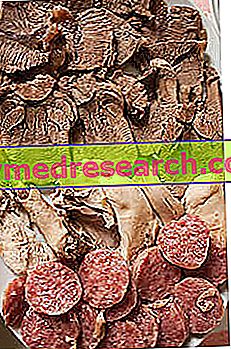Generality
"Bollito" means "cooked by boiling", then cooked through a heat treatment that uses the convection of hot water on the raw material to be cooked.
The fundamental requirement of this processing is that the water temperature AT THE TIME OF DIVING the food must be as high as possible.

However, the term "boiled" can also take on the meaning of "typical dish" based on meat, broth vegetables and (often but not always) sauces of various kinds. Boiled meat is a typical winter recipe, but in some places it is often consumed cold even in mid-seasons.
Boiled - Dish
Let's start by pointing out that there are as many variations of "boiled" as there are regions of Italy. Certainly, it is a typical dish of northern gastronomic culture and, not surprisingly, in addition to the simple one (of only adult animal beef), the most famous boiled meats are Piedmontese, Tyrolean and Veneto.
For the preparation of a good boiled it is necessary to keep in mind some fundamental concepts.
- Choose cuts of meat not too valuable, or better, of moderate cost. Boiled meat is born to make the most of certain parts of the front quarter of the beef, together with other components of the fifth-fourth (bones and offal). In this case, it is not required that the affected muscles be the softest since they will become longer with prolonged cooking; what matters, however, is their richness in collagen, which will give it a typically gelatinous consistency. If this is not acceptable to the diners, these cuts can be replaced with the bovine nut.
- Wanting to enrich a boiled meat of only adult beef or possibly veal (with or without capon, beef bones, cow's tail and veal nerves), it is possible to cook separately: bovine tongue, head, pig's trotter and cotechino di pig.
- The muscle should be cooked in an already structured flavored vegetable broth, immersed at full boil and continued at the lowest possible temperature without losing a slight boil (to prevent the meat from being destroyed and the broth from becoming cloudy).
Let's see in more detail how to easily prepare a "basic" boiled meat.
Ingredients
For every kg of beef (real, priest's hat, candy, neck, shoulder), 1 carrot, 1 celery stick, ½ onion, QB salt, water (about 3-4 liters).
Method
Inside a muffler, pour cold water with the peeled vegetables and cover. Simmer, continue for 30 'and season with salt. Boil to the maximum and dip the meat. After 5 ', lower the heat to a temperature that barely sees the convective motions of the broth. If necessary, foam the surface. Continue for about 3 hours, turn off, drain the meat and serve (cut on a tray or still to be cut served on a cutting board).
Now, let's analyze the most famous boiled recipe (which is probably also the most complex), or the Piedmontese boiled meat .
WARNING! The TRADITIONAL one is even more elaborate than the following; however, for newbies, this simplified version will already be quite demanding.
Ingredients
Beef in large pieces (royal, priest's hat, candy, neck, shoulder), ossobuco, capon, cow's tail, nerves, cow's tongue, head, trotter or cotechino; celery, carrots, onions and garlic; cloves, black peppercorns, bay leaves, parsley, thyme (rosemary at the discretion of the guests); ½ glass of vinegar at the discretion of the guests to add to the meat stock; water QB; Salt to taste.
Method
Prepare 3 pots with broth, as described in the previous recipe, also adding the aromatic herbs tied with a string in bunches (keep pepper and cloves apart). In the first pan, dip (with the same technique described above) the beef muscle, the capon, the bones, the nerves and the tail. In the second the tongue, in the third the head and, in a fourth pan with ONLY water, cotechino or zampone. Occasionally foam; when the boiled meat, tongue and head no longer produce any residues, add the pepper and cloves. Allow the boiled meat to cook for at least 3 hours, while the tongue, head and cotechino or zampone must be interrupted at the appropriate time. Then drain, cut the muscle into pieces, possibly the capon, keep only the ossobuco still full of marrow, peel the tongue and cut it, slice the head and also the cotechino or the zampone.
Order everything on a tray, along with the nerves and the tail. Serve hot, with the vegetables boiled separately (without the aromas), a bowl of filtered broth (ONLY THAT ONE OF MEAT) and the right sauces.
Sauces for boiled meat
The boiled meat can be accompanied both with its own cooking vegetables and with other appropriately selected sauces, but always with a bowl of hot broth.
In addition to the generic mayonnaise (of course, homemade!), Mustard sauce and yogurt sauce, the Piedmontese boiled requires the incontrovertible presence of green sauce, rubra sauce and horseradish sauce. To tell the truth, the Piedmontese Bollito Miste sauces are many more but, as anticipated, it is better to start with a more basic recipe.
At the same time, in the Po Valley area it is a collective habit to accompany this recipe with mustard sauce (from Cremona, Mantua, etc.), while in the whole of Veneto the delicious Pearà can be appreciated.
Pearà - Salsa per Bollito Carne
X Problems with video playback? Reload from YouTube Go to Video Page Go to Video Recipes Section Watch the video on youtubeNutritional Features
Boiled meat, understood as a simple muscle accompanied by broth vegetables, is not an excessively caloric dish. Of course, the nutritional intake depends above all on the type of cut used, but in principle it is possible to say that it is a dish that fluctuates between 150 and 250kcal / 100g, made mainly by proteins with high biological value and fat.
Then, considering the other ingredients of Bollito Misto Piemontese, the subject changes radically. In addition to the sauces, which in themselves contribute to considerably increasing the energy impact of the preparation, we recall that certain ingredients such as the tongue, the skin of the hen and the bone marrow have a more than significant cholesterol content. In addition, the tail, the cotechino, the zampone etc. they provide far more lipids than simple muscle or skinless capon meat.
As far as the micronutritional profile is concerned, boiled meat does not disappoint. The simple one is superimposable to the classic composition of the beef, while the Piedmontese Misto boasts concentrations of mineral salts (for example iron) and of vitamins A and B group definitely satisfactory. On the other hand, obviously, the contribution of carbohydrates, fiber, thermolabile vitamins and other phytotherapeutic molecules (such as phenolic substances and phytosterols) is almost insignificant or absent.
Finally, remember that boiled meat is a dish that is NOT suitable for those suffering from gastric disorders (hypochlorhydria, hyperchlorhydria, stomach acid, gastritis, peptic ulcer and gastro-oesophageal reflux). It is a dish quite difficult to digest, especially in the case in which (in addition to the considerable protein intake) it is characterized by other ingredients rich in fat.



